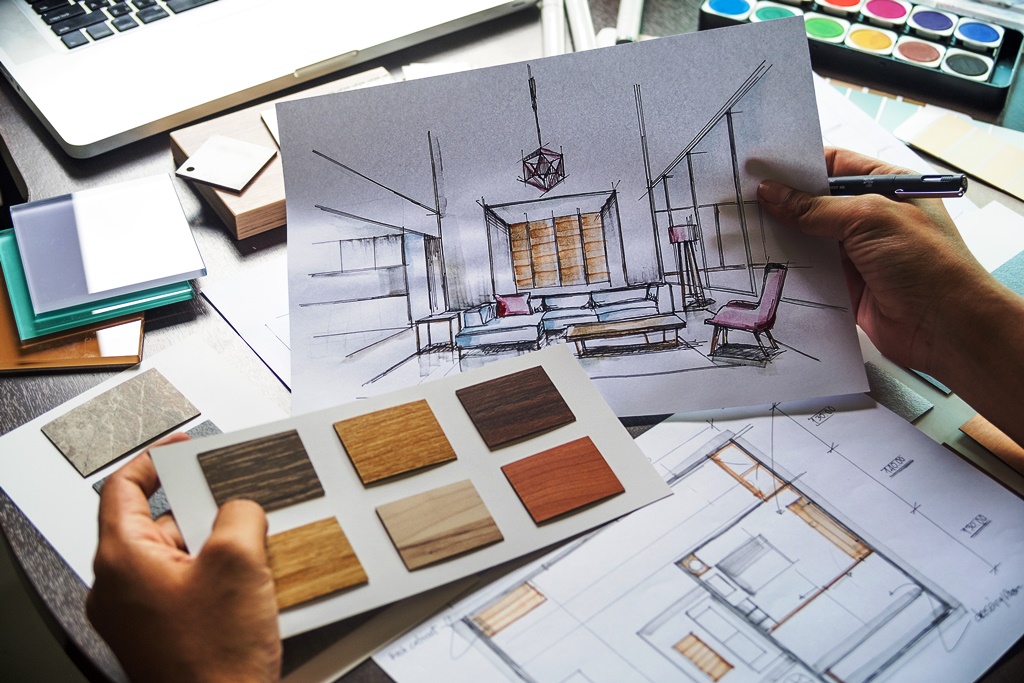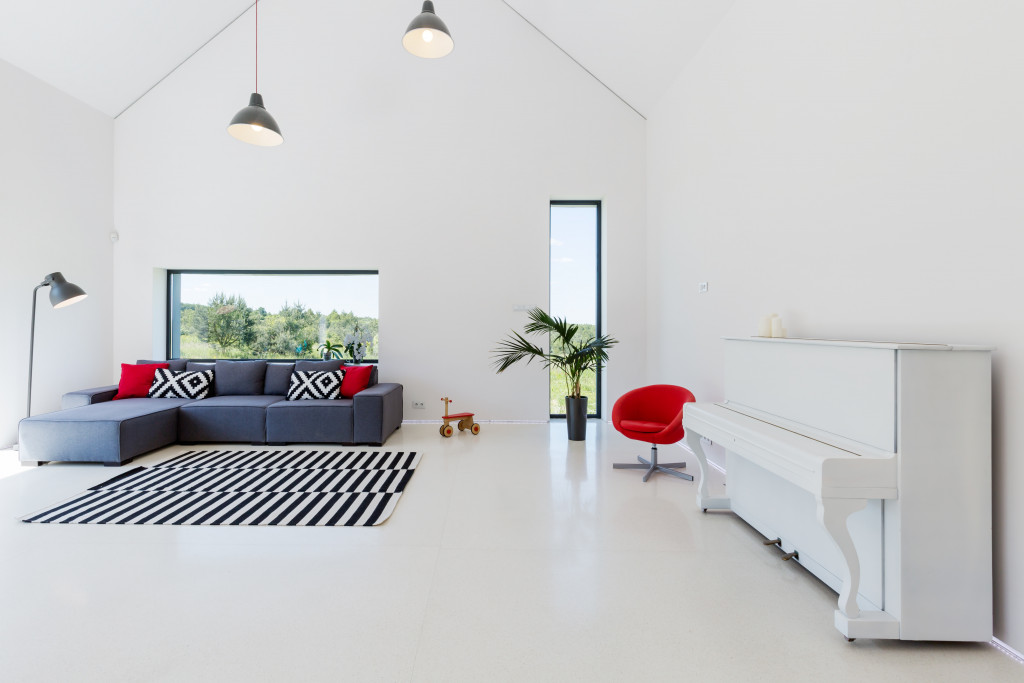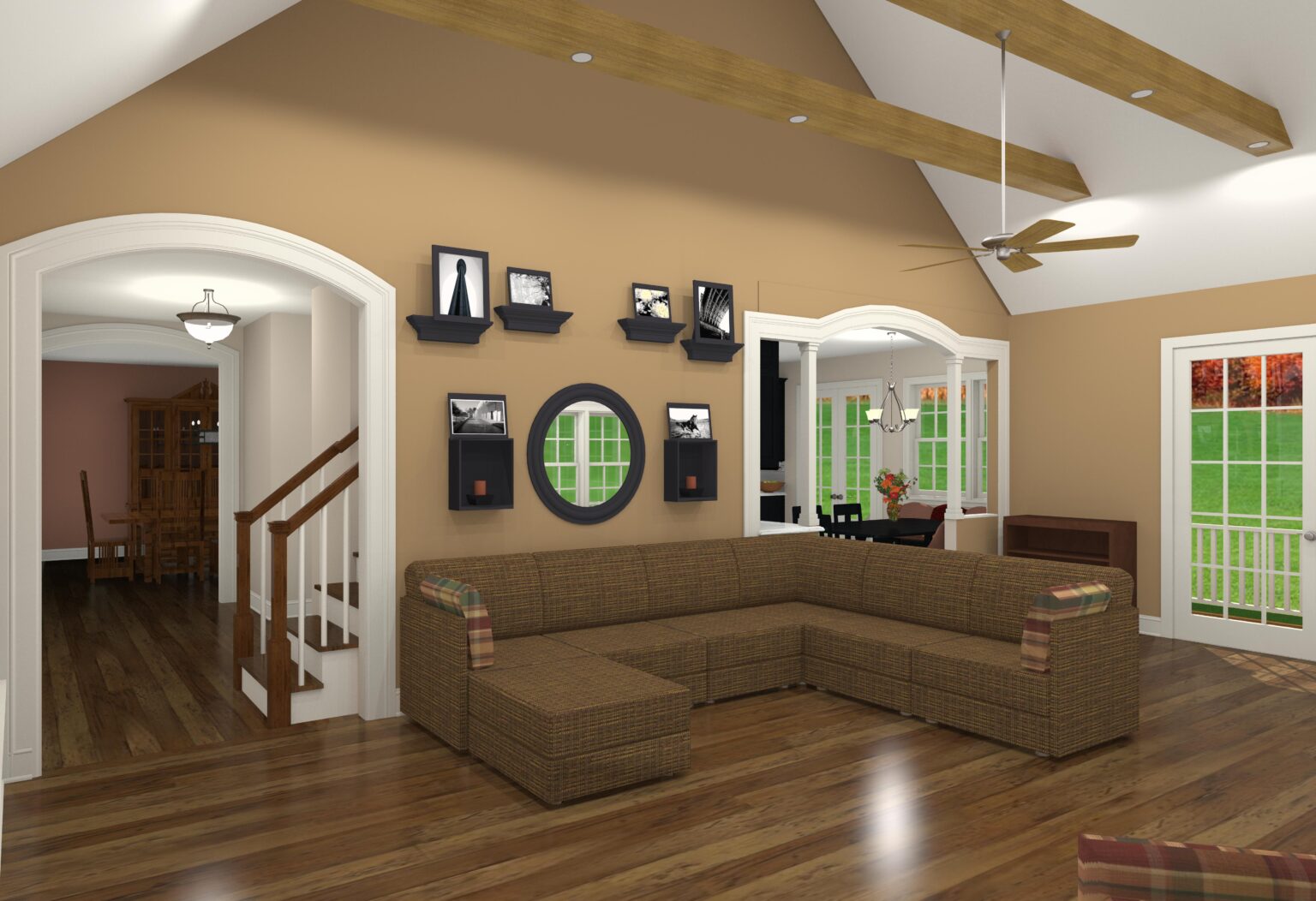Defining Your House Style

Before you start decorating, it's crucial to establish a clear vision for your home's style. This will guide your design decisions and ensure a cohesive and aesthetically pleasing outcome. Defining your house style involves identifying the key elements that resonate with your personal taste and lifestyle.
A consistent aesthetic vision creates a sense of harmony and unity throughout your home. It helps you make informed decisions about furniture, colors, materials, and accessories, preventing a chaotic mix of styles.
Common House Styles
Understanding common house styles can help you define your own aesthetic preferences. Here are a few examples:
- Modern: Characterized by clean lines, minimalist furniture, neutral color palettes, and a focus on functionality. It often incorporates natural materials like wood and stone, and features geometric shapes and open floor plans.
- Traditional: Emphasizes classic elegance, with ornate details, rich colors, and a sense of history. It often features furniture with intricate carvings, patterned fabrics, and formal layouts.
- Farmhouse: Embraces rustic charm, with warm colors, natural textures, and a focus on comfort. It often incorporates reclaimed wood, vintage furniture, and floral patterns.
- Minimalist: Strives for simplicity and functionality, with a focus on clean lines, neutral colors, and minimal decor. It emphasizes open spaces, natural light, and a sense of calm.
Color Palette and Materials
Color plays a crucial role in establishing a cohesive look throughout your home, creating a unified and visually appealing atmosphere. Choosing the right color palette can enhance the style you've defined, making it feel complete and intentional. Materials, from wood to stone to metal, also contribute significantly to the overall aesthetic, adding texture and character to your chosen style.
Color Palette Selection, Best practices for maintaining a consistent house style throughout the home
Choosing a color palette that complements your chosen style involves considering the mood and atmosphere you want to create. A harmonious color scheme ensures a visually pleasing and unified look throughout your home.
- Start with a Base Color: Select a neutral base color that serves as the foundation for your palette. This could be a soft white, a warm beige, or a cool gray. This base color will act as a backdrop for other colors and help create a sense of balance.
- Introduce Accent Colors: Choose two to three accent colors that complement your base color and reflect your chosen style. These accent colors can be bolder and more vibrant, adding pops of color and personality to the space. For example, if your base color is a soft white, you could choose a warm terracotta, a deep navy blue, and a vibrant emerald green as accent colors.
- Consider Lighting: Natural light can affect how colors appear, so consider how your chosen colors will look in different lighting conditions. For example, a color that appears vibrant in natural light may appear duller in artificial light.
- Create a Mood Board: A mood board is a visual tool that can help you visualize your chosen color palette. Gather inspiration from magazines, websites, and even nature. You can create a digital mood board using Pinterest or a physical mood board using fabric swatches, paint samples, and magazine clippings.
Material Selection
Materials contribute to the overall aesthetic of your home, adding texture, character, and a sense of warmth. They can be used in various applications, from flooring and furniture to wall coverings and accessories.
- Wood: Wood is a timeless material that adds warmth, natural beauty, and a sense of history to any space. It comes in various species, finishes, and grains, offering a wide range of options to complement different styles. Examples include oak, walnut, cherry, and maple.
- Stone: Stone is a durable and elegant material that adds a touch of sophistication and grandeur. It can be used for flooring, countertops, and even wall cladding. Examples include granite, marble, slate, and limestone.
- Metal: Metal adds a modern and industrial feel to a space. It comes in various finishes, from polished chrome to brushed nickel, and can be used for furniture, lighting, and hardware. Examples include stainless steel, brass, and copper.
- Fabric: Fabric plays a crucial role in creating a comfortable and inviting atmosphere. It can be used for upholstery, curtains, rugs, and throw pillows. Examples include linen, cotton, velvet, and silk.
Furniture and Decor

Furniture and decor play a crucial role in solidifying your chosen house style and creating a cohesive and visually appealing space. The right furniture and decorative elements can enhance the overall aesthetic and ensure consistency throughout your home.
Selecting Furniture That Complements the Style
Choosing furniture that complements your chosen style is essential for maintaining consistency. Consider the following tips:
- Choose furniture that reflects the style's characteristics. For example, if your style is modern, opt for sleek lines, minimalist designs, and neutral colors. If you prefer a traditional style, choose furniture with intricate details, ornate carvings, and warm tones.
- Pay attention to materials. Different styles often utilize specific materials. For example, modern styles may incorporate metal, glass, and leather, while traditional styles may use wood, fabric, and upholstery.
- Consider the scale and proportion of the furniture. Oversized furniture can overwhelm a small space, while too much small furniture can make a large room feel empty. Ensure the furniture pieces are well-proportioned and create a balanced look.
Decorative Elements That Enhance Consistency
Decorative elements like artwork, lighting, and textiles can further enhance the consistency of your house style.
- Artwork should reflect the style and color palette. For example, abstract paintings complement modern styles, while landscapes or still lifes are suitable for traditional styles. Ensure the artwork complements the colors and themes present in the room.
- Lighting can significantly impact the mood and ambiance of a room. Choose lighting fixtures that align with the chosen style. Modern styles may feature minimalist pendant lights, while traditional styles may use chandeliers or sconces with intricate details.
- Textiles play a vital role in creating a cohesive look. Curtains, rugs, and throw pillows should complement the furniture and overall style. Choose fabrics and patterns that align with the chosen aesthetic.
Balance and Scale in Furniture and Decor
Balance and scale are crucial for creating a visually pleasing and harmonious space. Consider the following:
- Ensure a balanced distribution of furniture and decor. Avoid placing all the furniture on one side of the room or overcrowding a space with too many items.
- Consider the scale of furniture and decor in relation to the size of the room. Large furniture pieces can overwhelm a small space, while small pieces may get lost in a large room.
- Use contrasting colors and textures to create visual interest and balance. For example, a dark sofa can be balanced with light-colored walls or a patterned rug.
Architectural Features

Architectural details play a crucial role in establishing and maintaining a consistent house style throughout your home. These details, from moldings to windows and doors, create a visual rhythm and harmony that ties the various spaces together. By thoughtfully integrating existing architectural features into your chosen style, you can enhance the overall aesthetic and create a cohesive and harmonious living environment.
Integrating Existing Architectural Features
Integrating existing architectural features into your chosen style involves a balance between preserving the character of the home and introducing your personal design preferences. Here are some ways to achieve this:
- Highlighting Unique Features: If your home boasts unique architectural elements like exposed beams, built-in cabinetry, or arched doorways, embrace them. Paint them in a color that complements your chosen palette, or use them as focal points by adding decorative accents or lighting.
- Updating Traditional Features: Traditional architectural elements like crown moldings or wainscoting can be updated to suit a modern style. Consider painting them in a bold color or using them as a backdrop for contemporary artwork.
- Adding New Features: Adding new architectural details, such as decorative trim, built-in shelving, or custom window treatments, can help to unify different areas of the home. Choose elements that complement the existing style and create a cohesive flow.
Impact of Architectural Choices
Architectural choices have a significant impact on the overall aesthetic of your home.
- Scale and Proportion: The size and proportion of architectural features influence the perceived size and flow of the space. Larger moldings can create a sense of grandeur, while smaller details can create a more intimate feel.
- Materials and Finishes: The materials used for architectural features, such as wood, stone, or metal, impact the overall style and ambiance. For example, rustic wood beams create a warm and inviting atmosphere, while sleek metal accents add a modern touch.
- Light and Shadow: The way light interacts with architectural features, such as moldings or windows, can dramatically influence the overall mood and ambiance. Consider using lighting strategically to highlight these features and create a desired effect.
Lighting and Mood

Lighting plays a crucial role in creating the desired atmosphere and enhancing the overall style of your home. It can transform a space from dull and lifeless to warm and inviting, or from casual and relaxed to sophisticated and elegant. By strategically using different types of lighting, you can highlight architectural features, showcase artwork, and create a cohesive and visually appealing environment.
Lighting Fixtures for Different House Styles
Lighting fixtures can be used to complement and enhance different house styles. Here are some examples:
- Traditional: Chandeliers, sconces, and pendant lights with ornate designs, crystal accents, and warm-toned bulbs are perfect for traditional homes. These fixtures add a touch of elegance and grandeur to the space.
- Modern: Minimalist and geometric lighting fixtures with sleek lines and neutral colors are ideal for modern homes. Think of pendant lights with exposed bulbs, linear track lighting, and recessed lighting for a contemporary look.
- Rustic: Warm and inviting lighting fixtures made from natural materials like wood, metal, or stone are perfect for rustic homes. Consider using lanterns, Edison bulb chandeliers, and sconces with distressed finishes.
- Industrial: Exposed bulbs, metal fixtures with industrial finishes, and vintage-inspired lighting are great choices for industrial-style homes. These fixtures create a raw and edgy atmosphere.
Highlighting Architectural Features and Artwork
Lighting can be used to draw attention to specific architectural features or artwork in your home.
- Architectural Features: Recessed lighting can be used to highlight architectural details like crown molding, vaulted ceilings, or exposed beams. Sconces placed strategically around the room can illuminate staircases, fireplaces, or entryways.
- Artwork: Track lighting or spotlights can be used to showcase artwork, sculptures, or other decorative items. By directing light onto the piece, you create a dramatic effect and draw the eye to the focal point.
Creating a Flowing Space: Best Practices For Maintaining A Consistent House Style Throughout The Home

A well-designed house doesn't just look good; it feels good to be in. A key element of achieving this is creating a sense of flow, seamlessly guiding the eye from one room to the next. This isn't about making your home feel like a single, open space, but rather about creating a sense of connection and continuity.
Using Furniture Placement and Color to Guide the Eye
Furniture placement plays a vital role in creating a sense of flow. Strategic placement can create visual pathways, leading the eye through the space. Consider using furniture to create a sense of balance and symmetry, or to break up a space into distinct zones.
- Use furniture to create a focal point: A large sofa or a statement piece can draw the eye, creating a natural starting point for your visual journey. This could be a fireplace, a beautiful artwork, or even a window with a stunning view.
- Use color to create a sense of connection: Consistent color schemes can help unify different spaces, creating a sense of cohesion and continuity. This doesn't mean every room has to be the same color, but using a common color palette throughout your home can create a sense of flow. For example, you could use a neutral color as a base and then add pops of color in different rooms, using the same accent colors in each space.
- Use furniture to guide the eye through doorways: Consider placing a console table or a piece of artwork near a doorway to draw the eye into the next room. This can create a sense of openness and flow, making the transition between spaces feel more natural.
The Importance of Consistent Flooring Throughout the Home
Consistent flooring throughout the home is crucial for creating a sense of flow and visual continuity. While you might choose different materials for different areas (like hardwood in living areas and tile in bathrooms), maintaining a similar color palette or style can create a cohesive look.
- Similar color palettes: Even if you use different flooring materials, opting for similar color palettes can create a unified look. For example, you could use a light wood flooring in the living room and a slightly darker wood flooring in the dining room, but both within the same color family.
- Consistent patterns: If you're using patterned flooring, consider using the same pattern throughout the home, or variations of the same pattern. This can create a sense of unity and visual interest, while still maintaining a cohesive look.
- Transitional elements: If you're using different flooring materials, consider using transitional elements to connect the spaces. This could be a rug, a piece of furniture, or even a change in color that helps to bridge the gap between the two spaces.
Maintaining Consistency Over Time
Maintaining a consistent house style is a long-term commitment, and it can be challenging as your needs and preferences evolve over time. You may find yourself wanting to refresh your space or incorporate new elements that reflect your changing lifestyle or current design trends. However, it's essential to find ways to integrate these new elements without compromising the overall aesthetic you've established.
Strategies for Incorporating New Elements
The key to maintaining consistency over time is to be mindful of your original design choices and find ways to incorporate new elements that complement them. This means understanding your original design vision and identifying the core elements that define your style. Here are some strategies for incorporating new elements while preserving the original aesthetic:
- Use a Limited Color Palette: When adding new pieces, choose colors that already exist in your color palette. This will help to create a sense of cohesion and prevent your home from feeling too cluttered or disjointed.
- Focus on Textures and Patterns: If you're looking to add visual interest, experiment with different textures and patterns. This can be done through furniture upholstery, rugs, throw pillows, or artwork. Choose patterns and textures that complement the existing ones in your home.
- Introduce New Elements Gradually: Don't try to overhaul your entire home at once. Instead, introduce new elements gradually, allowing yourself time to adjust to the changes. This will help to prevent your home from feeling overwhelming or inconsistent.
- Re-purpose Existing Items: Before purchasing new furniture or decor, consider repurposing items you already own. This can be a great way to refresh your space without spending a lot of money.
Tips for Updating Your Home
As your style evolves, you may find yourself wanting to update your home without completely overhauling it. Here are some tips for refreshing your space while maintaining your chosen style:
- Swap Out Accessories: Accessories like throw pillows, blankets, and artwork are easy to change and can have a big impact on the overall look and feel of a room. Experiment with different colors, patterns, and textures to create a fresh look.
- Repaint Walls: A fresh coat of paint can make a world of difference. Consider using a different shade within your existing color palette or adding an accent wall to create a focal point.
- Rearrange Furniture: Simply rearranging your furniture can give your home a new look and feel. Try moving furniture to different walls, creating new groupings, or adding in new pieces to change the flow of the room.
FAQ Guide
Best practices for maintaining a consistent house style throughout the home - What if my house has different architectural styles in different rooms?
Don't worry! You can still maintain a consistent style by focusing on common elements like color palettes, materials, and furniture. Consider using a neutral backdrop to unify the space and then introduce accent colors and patterns that complement the various architectural features.
How can I create a cohesive style when I have a limited budget?
Focus on key pieces that define your style and create a strong foundation. You can then incorporate affordable accents and accessories to add personality and interest. Look for deals on secondhand furniture and decor, and consider DIY projects to personalize your space.
What are some easy ways to update my home without compromising my chosen style?
Change out throw pillows, swap out artwork, add a rug, or introduce new lighting fixtures. These small changes can make a big difference in refreshing your home without requiring major renovations.
